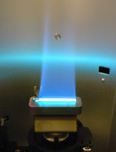Flame Atomic Absorption Spectroscopy
The ASU operates an Agilent, FS (Fast Sequential) 280 instrument. This is a sophisticated research grade atomic absorption spectrometer and offers the capability of performing routine flame based analysis of up to eight elements with a fully automated system at speeds comparable to an ICP-OES spectrometer.
Fast Sequential AA can cut analysis time and reduce sample consumption compared to conventional AA by measuring all elements in a sample before moving to the next sample.
Multiple elements are determined in rapid sequence allowing internal standard corrections to be applied on-line to correct for long term drift or sample preparation errors.
ASU FS280 Instrument - 8 Lamp Configuration
SELECTED APPLICATION NOTES (Agilent)
Features and Operation of Hollow Cathode Lamps and Deuterium Lamps (PDF, 221 KB)
Routine Maintenance for Atomic Absorption Spectrophotometers (PDF, 85 KB)
For Atomic Absorption spectrometry, 'flame mode' is the most common way to get atoms into a ground atomic state where they can be measured.
The flame in AA can be generated using a number of different combinations of fuel and oxidant. The most common pairing is air (as an oxidant, supplied from a compressor or pressurized tank) and acetylene (as the fuel).

Sample Introduction Pump System (SIPS)
Our FS280 instrument comes with a SIPS10 standard preparation and sample dilution feature. The SIPS feature removes tedious standard preparation steps and effectively extends the linear range of the instrument to reduce required sample dilutions.